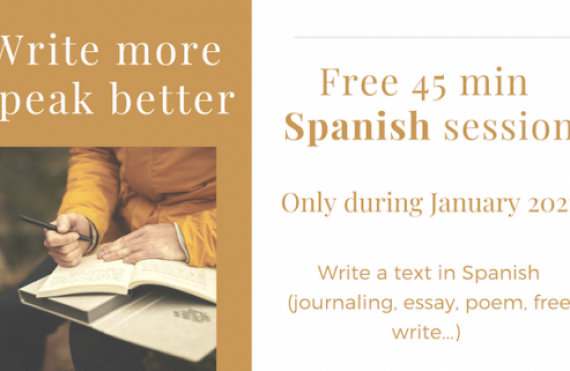
“I think a lot, but I don’t say much.”
– Anne Frank
“If you want to be fluent in Spanish you have to speak more”
“Speak from day one”
“Talk to strangers”
Speak.
Speak.
SPEAK
Ugh, exhausting!
If you are something like me: an introvert, talking in groups goes from being super exhausting to plain scary and, sometimes, an anxiety-inducing activity. It does not come easy. It does not flow.
It requires:
1) courage and
2) confidence in
a) your skills
b) your knowledge about the topic itself and
c) also, feeling somewhat comfortable with the person you are talking to.
Amongs other conditions.
That’s a lot of requirements.
In my book, Weaving Words: The Alchemy of Language I talk about how to reduce anxiety and making the task of talking in the target language as more hassle-free as possible. One of the best ways I know to reduce anxiety when we are talking in the target language is slowing down the conversation (I explain with detail how to slow down the conversation in the aforementioned book) but it is basically to breathe and take time to respond, give the time for your body and brain to catch up with the conversation.
What do you need to do to improve your Spanish speaking skills?
Every person is different and what works for extroverts (and advice that works for them is what you mostly find out there) might not work for introverts, who might end up feeling embarrassed or as a failure because they are trying to implement practises that go against their nature. Of course, they don’t work for you, but not because there is anything wrong with you!
After years of teaching to students across the board in terms of personality traits, I found what works better for introverts (and me too, being an introvert and language learner myself).
The key to speaking better is to…
… write more
… read more
… find people to have chats with (pressure-free, people you like and make you feel comfortable)
In this order.
Write first. Yes. It’s easier to write a 2 line personal text with the vocab and structures you have, than find texts to read that are interesting and inside your level.
Reading, when you have acquired some knowledge about sentence structures, verb conjugation and vocabulary, is essential.
And then, once you are comfortable journaling in Spanish about your immediate experiences and emotions and thoughts, then, and only then, I would recommend you to venture in the land of talking to other people.
But let’s go into more detail.
Write more
“Our culture made a virtue of living only as extroverts. We discouraged the inner journey, the quest for a center. So we lost our center and have to find it again.”
– Anais Nin
Write more and do it by hand. Typing in your computer is a reflection of current times, it’s fast-paced and ideal for not deep thinking. Writing by hand, on the contrary, helps you develop a stronger conceptual understanding than typing because handwriting forces your brain to mentally engage with the lines you are writing.
Quoting Sheldon H. Horowitz, Ed: “Research shows there’s something special about language development and the act of handwriting. In studies, kids who practice handwriting do better at reading and spelling. The reason? Some experts believe that forming letters by hand while learning sounds activates reading circuits in the brain that promote literacy.”
Handwriting, as a multisensory activity then, strengthens the learning process.
Activities you can do to practise your writing
- JOURNALING
I’ve written extensively about journaling as a way to practise and improve your Spanish. From why journaling works to different guided journaling practise to work on different Spanish grammar points, like prepositions, subjunctive or ser and estar.
- CREATIVE WRITING, like POETRY, for example.
If you have been reading this blog or following me for a while, you might have noticed my love for poetry and my advocacy to poetry as a way to improve your Spanish expression. If you haven’t, you can read more about this in my article: Why poetry is great to learn Spanish.
Read more
“What if you love knowledge for its own sake, not necessarily as a blueprint to action? What if you wish there were more, not fewer reflective types in the world.”
– Susan Cain
What do you need to have a fluent conversation about a topic you are interested in?
Words.
What is a great way of acquiring words? Reading.
Read in the target language as much as you can and about topics and genres you enjoy. In this article, I suggest five books for intermediate to advanced Spanish learners. But read, read anything you like, read books, blogs, post in social media… anything!
Reading allows the words seep in better than memorization will ever achieve. Why? Because we are not computers, we need a story and emotion to attach the meaning to the word so that it can be used.
Talk
“Silence is only frightening to people who are compulsively verbalizing.”
– William S. Boroughs
Speaking practise is, of course, necessary if your goal is to speak better Spanish, but it shouldn’t be the only one activity you practise in your search for fluency in Spanish and it doesn’t need to be the first thing you do if you don’t feel ready either.
Please, forget about the talk from day one that some people advocate for. Are they wrong? No. Does speaking from day one works from everyone? No. For some, trying to speak in the target language when we have barely a bunch of words and no confidence in our sentence building is stressful. And do you know what is worse than a lack of practice? A forced, stressful practise because when we link stress with a practice in a repetitive manner we are creating the opposite of positive reinforcement. If talking to strangers (ie. our language exchange or language teacher we have never met before or have little in common with) or talking in the target language is scary, and we do it but feel anxious, then the conversation won’t be successful.
There is something to say about feeling confident and comfortable (enough) with the task. I know, growth lives outside of your comfort zone, but not far outside, but more on the edges. It’s about working on the edge of your comfort zone and understanding well where your comfort zone is what is gonna lead you to a stress-free, (dare I say pleasurable?) expansive learning experience.
Solo talking opportunities
- Talk alone (in front of the mirror or to your pets or plants)
- Shadowing
- Talk to a chatbot
You can find more ideas on practising language alone in Lindie Botes article.
Once you are ready to talk to other people, whether because you feel confident about your language base (grammar and vocabulary wise), or because you have time to reflect and prepare for the conversation topic, then go ahead and engage with people in your target language, find language groups, or hire a conversation teacher…
The possibilities are endless! Just remember to be gentle with yourself and allow yourself to slow down the conversation so you can access the full extent of your knowledge.
“Stay true to your own nature. If you like to do things in a slow and steady way, don’t let others make you feel as if you have to race. If you enjoy depth, don’t force yourself to seek breadth.”
– Susan Cain
Write more Spanish to speak better Spanish.
Free 45-min Spanish session: write a piece in Spanish according to your level and I will help you with your grammar, expression, and structure. Only during this January 2021.



